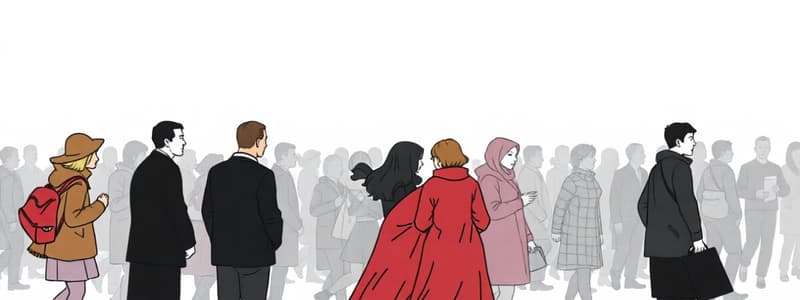Podcast
Questions and Answers
Which of these are key ideas of Merton's strain theory?
Which of these are key ideas of Merton's strain theory?
- A functioning society is one that is able to balance approved goals and approved means for achieving these goals. (correct)
- Durkheim's Anomie occurs when the relationship between approved goals and approved means for achieving these goals is broken. (correct)
What did Durkheim argue about pre-industrial societies?
What did Durkheim argue about pre-industrial societies?
Durkheim argued that pre-industrial societies had high levels of regulation through mechanical solidarity, keeping crime in check.
What is the key focus of Merton's 'Strain Theory'?
What is the key focus of Merton's 'Strain Theory'?
The key focus of Merton's 'Strain Theory' is the discrepancy between societal goals and the legitimate means of achieving those goals.
According to Durkheim, crime is a social construction.
According to Durkheim, crime is a social construction.
What did the Chicago School theorists observe about the city of Chicago?
What did the Chicago School theorists observe about the city of Chicago?
Which of the following was NOT a key finding of the Chicago School?
Which of the following was NOT a key finding of the Chicago School?
What does 'Strain Theory' propose as a possible cause of crime?
What does 'Strain Theory' propose as a possible cause of crime?
What is 'anomie' according to Durkheim?
What is 'anomie' according to Durkheim?
What is a key characteristic of 'mechanical solidarity'?
What is a key characteristic of 'mechanical solidarity'?
What is a key difference between strain theory and general strain theory?
What is a key difference between strain theory and general strain theory?
What are some of the policy implications of strain theory?
What are some of the policy implications of strain theory?
What is a main critique of the Chicago School theories?
What is a main critique of the Chicago School theories?
What is the key idea behind 'culture conflict theories'?
What is the key idea behind 'culture conflict theories'?
What is the main argument of 'class conflict theories'?
What is the main argument of 'class conflict theories'?
How can we best understand the meaning of 'subculture'?
How can we best understand the meaning of 'subculture'?
What is a significant limitation of 'culture conflict' theories?
What is a significant limitation of 'culture conflict' theories?
What kind of policy implications can be drawn from 'culture conflict' theories?
What kind of policy implications can be drawn from 'culture conflict' theories?
Flashcards
Sociological Explanation of Crime
Sociological Explanation of Crime
A theory that explains crime by looking at the social environment in which individuals live.
Functionalism
Functionalism
A theory that suggests crime is normal and even beneficial for society.
Anomie
Anomie
A state of normlessness or a breakdown in social norms.
Strain Theory
Strain Theory
Signup and view all the flashcards
Social Disorganization Theory
Social Disorganization Theory
Signup and view all the flashcards
Culture Conflict Theory
Culture Conflict Theory
Signup and view all the flashcards
Class Conflict Theory
Class Conflict Theory
Signup and view all the flashcards
Subculture
Subculture
Signup and view all the flashcards
Dissociation
Dissociation
Signup and view all the flashcards
General Strain Theory
General Strain Theory
Signup and view all the flashcards
Zone of Transition
Zone of Transition
Signup and view all the flashcards
Broken Windows Theory
Broken Windows Theory
Signup and view all the flashcards
Counterculture
Counterculture
Signup and view all the flashcards
Culture
Culture
Signup and view all the flashcards
Subcultural Theory
Subcultural Theory
Signup and view all the flashcards
Deviant Subculture
Deviant Subculture
Signup and view all the flashcards
Sociological Criminology
Sociological Criminology
Signup and view all the flashcards
Rational Choice Theory
Rational Choice Theory
Signup and view all the flashcards
Biological and Psychological Theories of Crime
Biological and Psychological Theories of Crime
Signup and view all the flashcards
Differential Association Theory
Differential Association Theory
Signup and view all the flashcards
Social Control Theory
Social Control Theory
Signup and view all the flashcards
Social Inequality Theories
Social Inequality Theories
Signup and view all the flashcards
Labeling Theory
Labeling Theory
Signup and view all the flashcards
Social Interactionist Theories
Social Interactionist Theories
Signup and view all the flashcards
Conflict Theory
Conflict Theory
Signup and view all the flashcards
Social Learning Theory
Social Learning Theory
Signup and view all the flashcards
Psychological Theories of Crime
Psychological Theories of Crime
Signup and view all the flashcards
Biological Theories of Crime
Biological Theories of Crime
Signup and view all the flashcards
Integrated Theories of Crime
Integrated Theories of Crime
Signup and view all the flashcards
Social Crime Prevention Policies
Social Crime Prevention Policies
Signup and view all the flashcards
Criminal Justice Policies
Criminal Justice Policies
Signup and view all the flashcards
Study Notes
Sociological Positivism
- Week 7 of the course is dedicated to sociological positivism
- Topics covered include Functionalism, Anomie and Strain; Chicago School; and Cultural/Sub-cultural theories.
Weekly Wellbeing Resources Drop-in
- Wellbeing resources are available on Tuesdays
- Drop-in times are between 12 pm and 2 pm.
- Locations include City Campus East (Business and Law Building), City Campus West (Student Skills Centre 2, Student Central), and Coach Lane (A1, Student Central).
- Students can find more information by scanning a QR code or searching "Weekly Wellbeing Resources Drop-in" in Ask4Help Online on their Student Portal (myportal.northumbria.ac.uk/Help-and-support).
Need Someone to Talk To?
- Northumbria University offers mental health support.
- Students can scan a QR code or search "An overview of mental health and wellbeing support at Northumbria" in Ask4Help Online on their Student Portal (myportal.northumbria.ac.uk/Help-and-support) for more information.
- A range of emotional support services are available, including support for anxiety, sadness, tiredness, loneliness, homesickness, overwhelm, stress, and worry.
Sociological Explanations for Crime
- This week's focus is on sociological explanations for crime.
- Sociological explanations are theories that analyze crime through the lens of social environments.
- The social environment is a significant factor in explaining crime and reactions to it.
- It is not the only factor though.
Criminological Theories Categorisation
- Criminological theories are categorized into four groups:
- Rational Actor Explanations
- Pre-Destined Actor Explanations
- Victimised Actor Explanations
- Integrated Explanations
Sociological Explanations for Crime - Reading
- Essential reading for week 6 includes Tim Newburn's book "Criminology", Third Edition, Part 2, Chapters 9 & 10.
- These chapters are available online via the module reading list.
Functionalism, Anomie, and Strain
- This concept explores the relationship between social structure and crime.
Functionalism (Durkheim)
- Durkheim suggests that crime is a normal and functional part of society.
- Collective moral frameworks define crime, and criminal punishment reinforces these norms.
- Crime, in this view, has boundary maintenance functions.
Functionalism & Crime: Anomie
- Anomie is a breakdown in societal norms related to rapid economic or social change
- Durkheim describes anomie as a breakdown in norms and common understandings.
- This can occur due to rapid social and economic changes and results in insufficient limits on individual desires.
Functionalism & Crime: Strain
- Merton expanded on Durkheim's concept of anomie, coining the term "strain theory."
- A functioning society balances approved goals and means for achieving them.
- Anomie occurs when this balance is disrupted.
Anomie and Strain - Approved Goals & Means
- Approved goals in modern capitalist societies are financial success, security, independence and ownership of goods and services.
- Approved means are education, employment, and entrepreneurship.
Anomie and Strain - Critique
- Exaggerates focus on money-making.
- Doesn’t adequately address diverse aspirations besides materialism.
- Lacks sufficient explanation of crimes committed by the wealthy and influential.
- Limited scope for explaining gender, age, and marginalised criminal behaviour.
General Strain Theory
- General Strain Theory modifies earlier strain theory.
- It explores how goals (beyond economic success) can lead to strain.
- Factors causing strain include bullying, rejection, abuse, unemployment and discrimination.
- Negative emotions, such as anger, stemming from strain, can lead to crime.
- It recognises that strain can be experienced differently by different genders, impacting likelihood of criminal behavior.
- The theory emphasizes the importance of negative emotions in shaping criminal behaviour.
Strain Theory - Policy Implications
- Policy implications include improving opportunities like education, employment and welfare.
- Realistic expectations to reduce strain.
- Learning from other societies' approaches to crime as a tool for influencing policies.
Chicago School Theories
- Focus primarily on urban environments.
- They examine how rapid industrialisation, population growth, and poverty affect crime rates in urban areas characterized by poor living and working conditions.
- Key theorists include Park, Burgess, Shaw, McKay and others.
Chicago School Theories - Shaw and McKay
- They highlighted spatial patterns of criminal behaviour.
- They observed higher crime rates in areas of socio-economic deprivation and instability.
- Their work led to the zone hypothesis: affluence and income is correlated with the city zones - poorer inner zones, wealthier outer zones, etc.
Chicago School Theories - Transition Zone
- The zone with higher crime rates despite changing population.
- Includes transient population, socio-economic deprivation, poor infrastructure and housing conditions
- The theory highlights areas of concentrated disadvantage.
Chicago School Theories - Evidence and Critique
- Data often shows higher crime rates in areas with social disorganisation and ethnic diversity.
- Critique often focuses on the under-emphasis on individual agency to explain crime and focuses on structural issues rather than the individual behaviour (causality is not clear).
- The theory has not held up well when applied in diverse non-Chicago-like locations.
Chicago School Policy and Practice Implications
- Focus on addressing social and economic issues in communities
- Includes improvement of community cohesion and resources for individuals, particularly in areas experiencing social disorganisation.
Cultural and Subcultural Theory
- Builds on the concepts of anomie, strain, and Chicago School ideas to address the socio-economic environment and goal achievement.
- This study notes explain how this is reflected in patterns of behaviour, identifying shared norms and values amongst groups as an element.
Culture and Subculture
- This perspective examines how subcultures - with their unique values and norms in contrast to mainstream society - can influence behaviours.
- It considers the relationship between subcultures and the dominant culture, commonly one of subordination involving power differences.
Culture and Subculture - Approaches
- Strain theories – subculture is a response to strain from not being able to reach approved goals.
- Culture conflict – the expected behaviours within a subculture may conflict or differ from wider societal views and norms.
- Class conflict – subcultures may arise as a response to lack of opportunity within mainstream society and may be associated with leisure activities such as styles of dress, cars etc.
Culture and Subculture - Conflict Theories
- Explores why some neighbourhoods’ values are in conflict with broader societal norms.
- Criminal law often reflects the values of the more powerful, which creates and shapes conflicts with other groups'.
Culture and Subculture- Limitations
- Over-emphasizes working-class delinquency.
- Fails to adequately consider gender variations in crime and youthful behaviour.
- Focus disproportionately on negative representations of subcultures, marginalizing the more mundane and commonplace behaviours.
Culture and Subculture - Policy Implications
- Community initiatives – social support and role models
- Educating society – demonstrating that youth subcultures are not criminal.
- Improving access to opportunities like access to education, and employment.
Summary of Theories, Critique, and Policy Implications
- Sociological explanations of crime cover Functionalism – Anomie – Strain; Chicago School; Subcultural theories; Culture Conflict; and Class Conflict, in order.
Studying That Suits You
Use AI to generate personalized quizzes and flashcards to suit your learning preferences.




